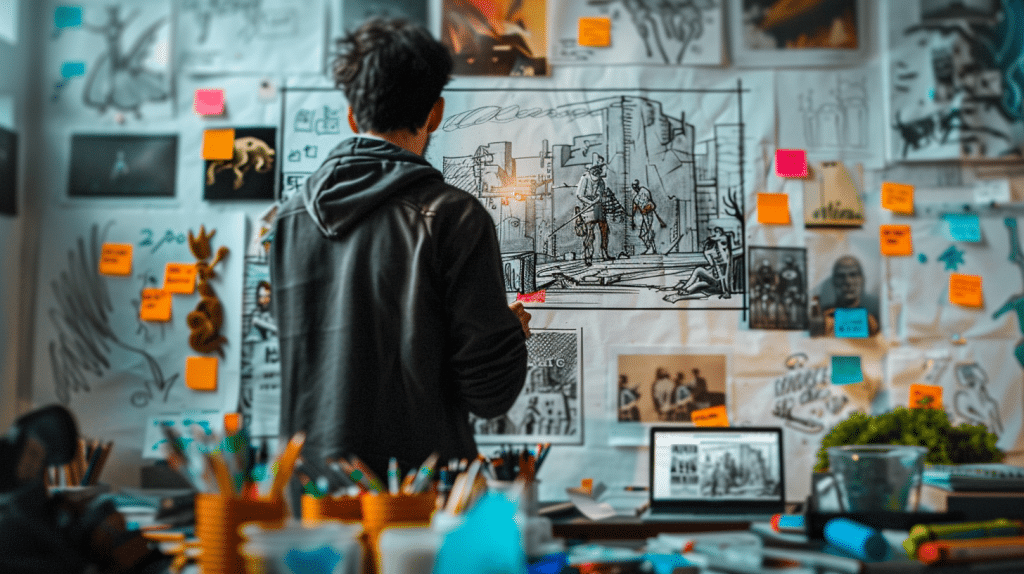Mastering Pre-Production Phases: Essential Tips for Filmmakers

As a filmmaker, you know that pre-production is like laying the foundation for a building—essential for the structure’s stability and success.
Imagine the anticipation of bringing your vision to life, carefully planning each detail to guarantee a seamless execution.
But what happens when unexpected challenges arise? How do you adapt and keep your vision on track?
This guide explores the essential tips for mastering pre-production phases, ensuring a resilient and adaptable filmmaking journey.
Table of Contents
Script Development

In script development, you’ll need to refine your story idea into a structured narrative that serves as the foundation for your production.
This phase is vital, as it lays the groundwork for all the creative elements that will follow.
Start by outlining the main plot points, character arcs, and thematic elements that you want to explore in your project. Consider the pacing, dialogue, and overall tone to make sure that your script effectively communicates your vision.
Collaboration is key during script development. Seek feedback from peers, mentors, or script consultants to strengthen your story. Be open to constructive criticism, and be prepared to revise your script multiple times.
Remember that this process is iterative, and each revision brings you closer to a polished final draft.
As you refine your script, keep in mind the budget and logistical constraints of your production. Make sure that your story is feasible within the resources available to you.
By investing time and effort into script development, you establish a strong foundation for a successful production.
Casting

Refine your script into a compelling narrative that sets the stage for the next critical phase: Casting.
This phase involves selecting the actors who’ll bring your characters to life.
Start by creating character breakdowns detailing the age, physical appearance, personality traits, and any specific skills required.
Consider holding auditions to see how different actors interpret the roles. Look for individuals who not only fit the character descriptions but also bring a unique perspective to the role.
Collaborate closely with your casting director to make sure that the actors chosen align with the vision you have for your project. Remember that casting isn’t just about finding talented individuals; it’s also about creating a cohesive ensemble that works well together.
Be open to exploring new talent while also considering experienced actors who can elevate your production.
Once you have selected your cast, work on building rapport and conducting rehearsals to fine-tune performances.
Effective casting can greatly enhance the overall quality of your production, so take the time to make thoughtful decisions in this phase.
Location Scouting

When scouting for locations, engage in meticulous research and on-site visits to identify settings that authentically align with your project’s vision and logistical requirements.
Start by defining key elements needed for each scene, such as the type of environment, architecture, and overall ambiance.
Utilize online resources, location databases, and social media platforms to gather potential options. Narrow down choices based on compatibility with your script, budget, and accessibility for the cast and crew.
Once you’ve compiled a list of potential locations, schedule site visits to assess each one carefully. Pay attention to lighting conditions, noise levels, parking availability, and any necessary permits. Take detailed notes, photos, and videos to share with the production team for further evaluation.
Collaborate with key stakeholders to weigh the pros and cons of each location, considering factors like travel time, accommodation options, and overall production design.
Budgeting

Begin by meticulously analyzing and categorizing all anticipated expenses to establish a thorough budget for your upcoming production.
Budgeting is a vital aspect of pre-production that demands careful consideration and planning.
Start by outlining major categories such as crew salaries, equipment rentals, location fees, permits, transportation, catering, and post-production costs. Break down each category into specific line items to make sure all expenses are accounted for.
Collaborate with key members of your team, such as producers, line producers, and accountants, to gather accurate cost estimates. Consider creating different scenarios to account for unexpected expenses and fluctuations in costs.
Utilize budgeting tools and software to help streamline the process and track expenses effectively.
Regularly review and adjust your budget as needed throughout the pre-production phase. Stay organized by maintaining detailed records of all expenses and receipts.
Remember that a well-planned budget not only helps you control costs but also ensures a smoother production process overall.
Production Design

To enhance the visual storytelling of your production, focus on meticulously planning and executing the production design elements.
Production design encompasses the overall look and feel of your project, including sets, props, costumes, and visual aesthetic. Collaborating closely with your production designer is vital to guarantee that the design aligns with your vision and enhances the narrative.
Start by discussing your creative vision with the production designer. Provide them with details about the story, characters, and desired atmosphere.
Together, develop mood boards, sketches, and color palettes to visually represent the design concept. Consider the practical aspects of the design, such as budget constraints and location availability.
Once the initial concepts are approved, work on creating detailed design plans. This includes blueprints for sets, prop lists, and costume sketches. Pay attention to even the smallest details, as they can have a significant impact on the overall production quality.
Regularly communicate with your production designer and other key team members to ensure everyone is in sync with the design vision.
By prioritizing production design, you can create a visually engaging and cohesive project that resonates with your audience.
Scheduling

Discussing the scheduling for your production requires thorough coordination to guarantee all aspects of the project align smoothly and efficiently.
A well-thought-out schedule serves as the backbone of your production, ensuring that tasks are completed on time and resources are utilized effectively.
Start by listing all the necessary steps in the production process, from casting to filming to post-production.
Assign realistic timeframes to each task, considering factors like location availability, actor schedules, and equipment rentals. It’s crucial to build in buffer time for unexpected delays or revisions.
Collaborate closely with key team members, such as the director, producer, and department heads, to create a detailed schedule that accommodates everyone’s needs and deadlines.
Regularly review and adjust the schedule as needed to stay on track and adapt to any changes that may arise.
Storyboarding

When storyboarding your production, make sure that each scene is visually planned out to effectively communicate the narrative flow and shot sequences.
Storyboarding is an important step in pre-production that helps align the creative vision of the director, cinematographer, and other key crew members.
Start by sketching each shot or scene, indicating details like camera angles, movements, and character positions. Consider the pacing, mood, and overall visual style you want to achieve.
Collaborate with your team to make sure everyone is on the same page regarding the visual direction of the project.
Storyboards serve as a blueprint for the production process, guiding decisions on lighting, framing, and editing. They can also help save time and resources during the shoot by providing a clear roadmap for capturing essential shots efficiently.
Remember to be open to feedback and revisions as you refine the storyboard to best represent your creative vision.
A well-executed storyboard can greatly streamline the production process and enhance the overall quality of your project.
Rehearsals

Guarantee that your team is prepared and in sync by conducting thorough rehearsals to refine performances and iron out any potential issues before the actual production begins.
Rehearsals are a vital phase in pre-production that allows everyone involved to understand their roles, timing, and coordination.
Start by scheduling regular rehearsals well in advance to make sure everyone’s availability. During rehearsals, encourage open communication and feedback to address any concerns or suggestions for improvement.
It’s important to run through the script multiple times, focusing on blocking, dialogue delivery, and overall pacing.
Assign specific tasks to team members, such as monitoring props or sound cues, to ensure a smooth rehearsal process.
Utilize this time to experiment with different interpretations or actions to find the most effective approach. Remember to document any changes or notes for future reference.
Additionally, consider recording rehearsals to review performances and make necessary adjustments.
By investing time and effort into rehearsals, you set a solid foundation for a successful production.
Frequently Asked Questions
Why is script development crucial in the pre-production phase?
Script development is vital in the pre-production phase because it forms the foundation of your entire project.
A well-crafted script guides all creative elements, including direction, acting, and production design. It ensures that the narrative is cohesive and compelling, helping to communicate your vision effectively.
During this phase, refining the script through multiple revisions and feedback sessions is crucial to address any plot holes, pacing issues, or character inconsistencies. By investing time in script development, you set a strong groundwork for a successful production.
How can effective casting enhance a film’s quality?
Effective casting enhances a film’s quality by bringing characters to life in a way that resonates with the audience.
Selecting the right actors involves creating detailed character breakdowns and holding auditions to find individuals who not only fit the physical and personality traits of the characters but also bring a unique perspective to the role. A well-cast ensemble ensures chemistry and believability, which are crucial for engaging performances.
Additionally, experienced actors can elevate the overall production by adding depth and nuance to their roles, ultimately enhancing the film’s storytelling.
What are the key considerations during location scouting?
Key considerations during location scouting include the visual alignment with your project’s vision, logistical feasibility, and budget constraints.
Begin by identifying the specific needs of each scene, such as environment type, architecture, and ambiance. Utilize online resources and databases to compile a list of potential locations, then conduct on-site visits to assess lighting conditions, noise levels, and accessibility.
Consider practical aspects like permits, parking, and accommodations for cast and crew. Collaboration with key stakeholders is essential to evaluate the pros and cons of each location, ensuring it meets both creative and logistical requirements.
How does meticulous budgeting contribute to a successful production?
Meticulous budgeting contributes to a successful production by ensuring that all anticipated expenses are accounted for, preventing financial shortfalls during filming.
Start by categorizing expenses into crew salaries, equipment rentals, location fees, permits, transportation, catering, and post-production costs. Use budgeting tools to track and manage expenses, and consider creating contingency funds for unexpected costs.
Regularly review and adjust the budget as needed. A well-planned budget not only controls costs but also ensures a smoother production process, allowing for better allocation of resources and minimizing financial stress.
What role does production design play in visual storytelling?
Production design plays a crucial role in visual storytelling by creating the overall look and feel of the film, which enhances the narrative.
This includes sets, props, costumes, and the visual aesthetic of the project. Collaborate closely with the production designer to develop mood boards, sketches, and color palettes that align with your creative vision.
Detailed design plans, including blueprints for sets and costume sketches, help to create an immersive and believable world for the audience. Attention to detail in production design can significantly impact the visual appeal and emotional resonance of your film, making it a key element in successful storytelling.
Share:
Search our blog:
Follow us on:
